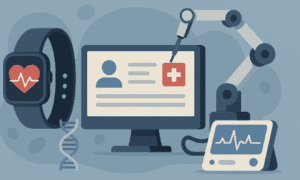Among the various branches of biotechnology, genetic engineering stands out as a revolutionary field that holds immense potential for transforming healthcare as we know it. This article explores the latest biotechnological breakthroughs, focusing on how genetic engineering is reshaping the healthcare industry and paving the way for unprecedented advancements.
Understanding Genetic Engineering
Genetic engineering involves the manipulation of an organism’s genes, allowing scientists to modify its characteristics or introduce new traits. In healthcare, this technique is leveraged to address a myriad of challenges, from treating genetic disorders to developing more effective medications. The precision and specificity of genetic engineering enable scientists to target and modify genes with unparalleled accuracy.
Genetic Engineering in Disease Prevention
One of the most promising aspects of genetic engineering is its role in disease prevention. Scientists can now identify and modify genes associated with hereditary diseases, significantly reducing the risk of passing on genetic disorders to future generations. The ability to edit genes also opens avenues for preventing diseases like cancer by eliminating or modifying predisposing genetic factors.
CRISPR-Cas9: A Game-Changing Tool
At the forefront of genetic engineering breakthroughs is CRISPR-Cas9, a revolutionary tool that allows scientists to edit DNA with unparalleled precision. CRISPR-Cas9 acts as a pair of “molecular scissors,” enabling researchers to cut, edit, and replace specific DNA sequences. This technology has immense potential for developing targeted therapies for various genetic disorders, including those with no previous treatment options.
Applications in Disease Treatment
CRISPR-Cas9 is not only a powerful tool for preventing genetic diseases but also for treating them. Researchers are exploring its applications in modifying genes within living organisms, offering hope for curing diseases that were once considered incurable. Diseases such as sickle cell anemia and certain types of muscular dystrophy are now under the scrutiny of CRISPR-Cas9 for potential therapeutic interventions.
Personalized Medicine and Genetic Engineering
The era of personalized medicine is dawning, thanks to genetic engineering. By analyzing an individual’s genetic makeup, healthcare providers can tailor treatment plans to match the patient’s unique genetic profile. This approach not only enhances treatment efficacy but also minimizes side effects, offering a more patient-centric and efficient healthcare experience.
Predictive Medicine
It allows for the identification of genetic markers associated with an increased risk of certain diseases. This enables healthcare professionals to implement proactive measures, providing individuals with personalized advice on lifestyle changes, screening protocols, and preventive treatments based on their genetic predispositions.
Gene Therapy: Correcting Genetic Aberrations
Gene therapy, a subset of genetic engineering, involves introducing, removing, or changing genetic material within a patient’s cells to treat or prevent disease. Recent successes in gene therapy include treatments for previously incurable genetic disorders such as spinal muscular atrophy and certain types of inherited blindness. These breakthroughs showcase the transformative power of genetic engineering in addressing previously untreatable conditions.
Expanding the Therapeutic Arsenal
As the technique evolve, the scope of treatable conditions widens. Researchers are exploring gene therapy applications for a broad spectrum of diseases, from rare genetic disorders to more common conditions like cardiovascular diseases and neurodegenerative disorders. The potential to correct genetic aberrations opens up new frontiers in medicine, offering hope to patients who were once left with limited treatment options.
Vaccines and Genetic Engineering
The development of vaccines has also benefited from genetic engineering techniques. With the ability to manipulate the genetic material of viruses and bacteria, scientists can design vaccines that are more targeted and effective. This has been particularly evident in the rapid development of mRNA vaccines, such as those against COVID-19, where genetic engineering plays a central role in instructing cells to produce virus-specific proteins for immune system response.
Next-Generation Vaccines
Genetic engineering is propelling the development of next-generation vaccines with improved efficacy and safety profiles. The adaptability of genetic engineering allows for the rapid design and production of vaccines tailored to emerging infectious diseases. This not only enhances our ability to respond to pandemics but also offers a more efficient and scalable approach to vaccine development.
Engineering Microorganisms for Drug Production
This technology is not limited to manipulating human genes; it extends to the modification of microorganisms for drug production. Scientists can engineer bacteria and yeast to produce pharmaceutical compounds, offering a more cost-effective and sustainable approach to drug manufacturing. This not only accelerates the drug development process but also contributes to reducing the environmental impact of pharmaceutical production.
Biofactories and Sustainable Drug Development
Genetically engineered microorganisms serve as biofactories, producing therapeutic proteins, enzymes, and other pharmaceutical components. This sustainable approach to drug development minimizes the reliance on traditional manufacturing methods, lowering costs and reducing the environmental footprint of pharmaceutical production. The versatility of genetic engineering in microorganisms opens new possibilities for the development of innovative and eco-friendly drugs.
Ethical Considerations and Genetic Engineering
As genetic engineering advances, ethical considerations become increasingly important. The ability to edit genes raises questions about the potential misuse of this technology, including concerns about “designer babies” and unintended consequences. Striking a balance between scientific progress and ethical responsibility is crucial to ensure that it is harnessed for the greater good of humanity.
Ethical Guidelines and Responsible Innovation
The scientific community is actively engaged in establishing ethical guidelines and frameworks to govern the responsible use of genetic engineering. Collaborative efforts between scientists, ethicists, policymakers, and the public are essential to ensure that genetic engineering applications align with societal values and prioritize the well-being of individuals and communities. Ongoing dialogues and ethical assessments play a pivotal role in shaping the responsible future of genetic engineering in healthcare.
Challenges and Future Prospects
While genetic engineering holds immense promise, it is not without challenges. Off-target effects, ethical dilemmas, and the need for extensive research to understand the long-term consequences of gene editing are among the hurdles that scientists face. However, ongoing research, technological advancements, and collaborative efforts across the scientific community continue to address these challenges, paving the way for a future where genetic engineering plays a central role in healthcare innovation.
Addressing Off-Target Effects
Efforts are underway to refine genetic engineering techniques and minimize off-target effects. Advancements in precision gene-editing tools, enhanced delivery systems, and improved understanding of genetic interactions contribute to mitigating the risks associated with unintended consequences. Continuous refinement of methodologies ensures that it remains a safe and effective tool in the hands of researchers and healthcare practitioners.
Long-Term Impact Studies
To fully harness it’s potential, comprehensive studies on the long-term impacts of gene editing are essential. Researchers are conducting rigorous investigations to assess the safety and stability of genetically modified organisms and the potential consequences of heritable gene edits. These studies are critical in shaping regulatory frameworks and ensuring the responsible deployment of such technologies.
Global Collaboration for Healthcare Innovation
The global scientific community is increasingly recognizing the importance of collaboration in advancing genetic engineering applications. Collaborative research initiatives, data sharing, and international partnerships facilitate the rapid exchange of knowledge and accelerate the pace of innovation. This collaborative approach not only enhances the robustness of scientific findings but also ensures that genetic engineering breakthroughs benefit diverse populations worldwide.
Conclusion
The landscape of healthcare is undergoing a transformative shift, and genetic engineering stands as a beacon of hope in the realm of biotechnological breakthroughs. From preventing hereditary diseases to developing personalized treatments, the applications of genetic engineering are reshaping the way we approach healthcare. As researchers delve deeper into the intricacies of our genetic code, the potential for even more groundbreaking discoveries and advancements in healthcare remains limitless, promising a future where genetic engineering revolutionizes the very fabric of medical science. The ongoing journey is not without its challenges, but with responsible innovation, ethical considerations, and global collaboration, we are poised to unlock unprecedented possibilities for the benefit of humanity’s health and well-being.



































